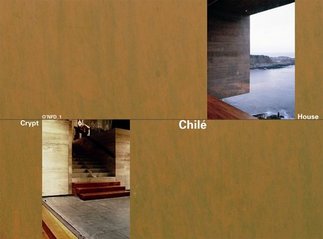Publikation
Chilé
O’Neil Ford Duograph Series, Vol. 1
ISBN: 3803006856
Beiträge von: Kevin Alter, Rodrigo Perez de Arce, Smiljan Radic, Wilfried Wang
Sprache: Englisch
Publikationsdatum: 2008
Umfang: 128 S.,
Format: Pappband, 21.5 x 29 cm
House at Punta Pite, 2003-06 by Smiljan Radic
Crypt in the Cathedral of Santiago de Chile, 1999-2006 by Rodrigo Perez de Arce
From the magnificent and moving coast of Chile to the inner sanctum of colonial Chile, two projects give an in-depth insight into the intensity and quality of contemporary architecture there. In Smiljan Radic's House in Punta Pite, archaic architecture and art are merged with precise details and modern design to create a home for a young family that is in constant and intimate contact with the elements. In Rodrigo Perez de Arce's realized competition entry for the post-facto insertion of a crypt in the cathedral of Santiago de Chile, two cultures are synthesized in an architectural tour-de-force, this as the matter-of-fact modern language of the new crypt fits unquestionably into the layers of colonial architectural history.
On the face of it, Smiljan Radic's House at Punta Pita and Rodrigo Perez de Arce's crypt are two commissions that could not be further apart from each other: the one affirming the realm of the living, the other dedicated to the dead. As opposite as they might seem, the conceptual framework and design constraints that each building confronts define the temporal and spatial limits of architecture themselves. Each project is a fundamental instance of architecture's need to constantly re-establish its temporal presence with every act of building. The first and the last house as it were: the one on the coastal paradise built for the financially independent „Adam“ and the other right at the colonial heart of the city that bears the name of the biblical St. James, name giver to numerous cities in the Spanish speaking world (notably Santiago de Compostela in Spanish Galicia).
Both architects practice in the capital of Chile, both lead small offices, both have known each other for years and have been teachers at the School of Architecture at the Pontifical Catholic University of Chile. Despite the decades of political turmoil and economic instability, the School of Architecture under the long serving Dean Fernando Oyarzun has been a leader in the South American and international architectural discourse. Whereas the northern hemisphere has neglected the southern hemisphere not only in cultural matters, the curious and open minded, the critical and sensitive observers in Santiago de Chile have documented their breadth of awareness of contemporary architecture in their numerous and impressive publications, notably the journal ARQ and its related monographs.
Richly illustrated and insightfully notated, this first volume in the O'Neil Ford Duograph Series, like those that will follow, gives examples, two at a time, of what is best in architecture today yet overlooked around the world. To this aim the Center for American Architecture and Design (CAAD) and the O'Neil Ford Chair in Architecture at the University of Texas at Austin, School of Architecture have joined forces. Each issue will document in some detail one building each by two different architects from a single country. These buildings will be complemented by descriptions from the respective architects and external critics.
Parallel to the O'Neil Ford Duographs the Center for American Architecture and Design and the O'Neil Ford Chair are launching a sister series entitled the O'Neil Ford Monographs. This latter series will document the complex gestation of single buildings of central importance to architecture.
On the face of it, Smiljan Radic's House at Punta Pita and Rodrigo Perez de Arce's crypt are two commissions that could not be further apart from each other: the one affirming the realm of the living, the other dedicated to the dead. As opposite as they might seem, the conceptual framework and design constraints that each building confronts define the temporal and spatial limits of architecture themselves. Each project is a fundamental instance of architecture's need to constantly re-establish its temporal presence with every act of building. The first and the last house as it were: the one on the coastal paradise built for the financially independent „Adam“ and the other right at the colonial heart of the city that bears the name of the biblical St. James, name giver to numerous cities in the Spanish speaking world (notably Santiago de Compostela in Spanish Galicia).
Both architects practice in the capital of Chile, both lead small offices, both have known each other for years and have been teachers at the School of Architecture at the Pontifical Catholic University of Chile. Despite the decades of political turmoil and economic instability, the School of Architecture under the long serving Dean Fernando Oyarzun has been a leader in the South American and international architectural discourse. Whereas the northern hemisphere has neglected the southern hemisphere not only in cultural matters, the curious and open minded, the critical and sensitive observers in Santiago de Chile have documented their breadth of awareness of contemporary architecture in their numerous and impressive publications, notably the journal ARQ and its related monographs.
Richly illustrated and insightfully notated, this first volume in the O'Neil Ford Duograph Series, like those that will follow, gives examples, two at a time, of what is best in architecture today yet overlooked around the world. To this aim the Center for American Architecture and Design (CAAD) and the O'Neil Ford Chair in Architecture at the University of Texas at Austin, School of Architecture have joined forces. Each issue will document in some detail one building each by two different architects from a single country. These buildings will be complemented by descriptions from the respective architects and external critics.
Parallel to the O'Neil Ford Duographs the Center for American Architecture and Design and the O'Neil Ford Chair are launching a sister series entitled the O'Neil Ford Monographs. This latter series will document the complex gestation of single buildings of central importance to architecture.
Weiterführende Links:
Wasmuth Verlag GmbH







